A Work Breakdown Structure (WBS) helps you to break down projects of any size into manageable tasks. It can integrate scope, cost, and deliverables into a single tool.
Yet, with many agencies, proper project planning is often overlooked.
Whether you handle complex or simple projects, this guide will teach you how to create a WBS to deliver more profitable and timely projects.
What is a Work Breakdown Structure?
A Work Breakdown Structure is a hierarchical outline of the tasks required to complete a project. The WBS “breaks down” the structure of a project into manageable deliverables or phases.
It helps organize, visualize, and manage projects more efficiently. It serves as a framework for detailed cost estimation and control and an overall project schedule guide.
Types of Work Breakdown Structures
The two main types of WBS are:
- Deliverable-based
- Phase-based
Deliverable-based Work Breakdown Structures show the relationship between project deliverables (blog posts, animations, and software) and the project’s scope (the work needed).
Here’s an example of a part deliverable-based WBS for a marketing campaign.
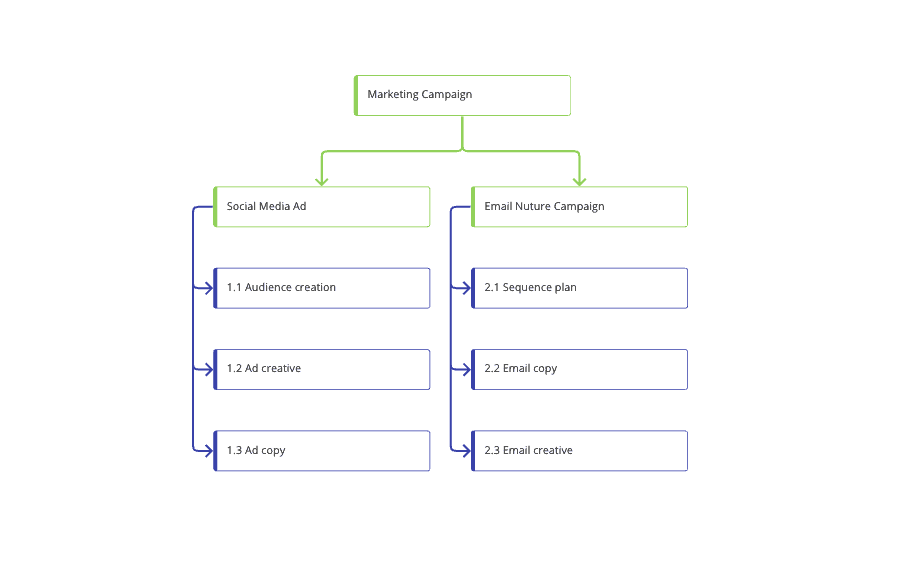
Phase-based Work Breakdown Structures organize the project work and required deliverables by the typical phases your project goes through.
Here’s an example of a phase-based WBS for a marketing campaign.
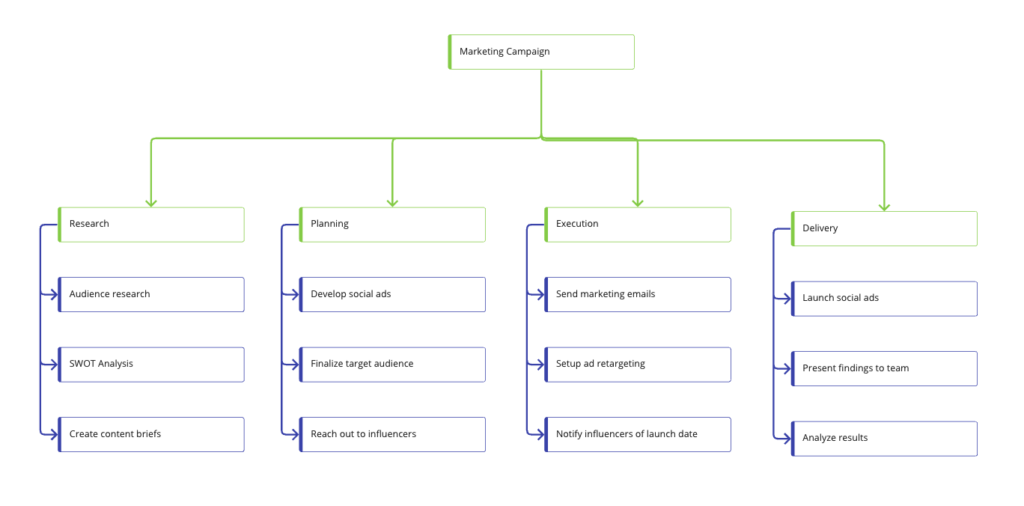
This WBS describes each step taken to complete the work within each phase.
It’s entirely up to you what type of WBS you use. But we’ll look at how each can be created below.
How to create a Work Breakdown Structure
Here’s how to create a simple WBS in 6 steps
1. Collect project requirements
2. Establish the significant project phases/deliverables
3. Break down each project phase into smaller tasks
4. Assign a time estimate to each task
5. Double-check that your tasks are unique
6. Share the final WBS with your team and gather feedback
1. Collect the project requirements
Gathering project requirements can be tricky. It’s more than asking a couple of questions — it’s a nuanced skill.
Try the following methods below and see how they fit into your process. You’ll find what methods work best for you in time, so start experimenting with your team and see how it goes.
Here’s a summary of our top methods for collecting project requirements.
| Questionnaires | Questions and surveys about stakeholder requirements and their issues, wants, and needs. |
| Expert judgment | Drawing on your own experience to help a client discover their needs. |
| Mind mapping with your team | Visual brainstorming to map out ideas and thoughts. |
| Historical project data | Looking back at similar past projects and reviewing them for helpful details. |
We recommend checking out our guide on gathering project requirements to learn more about becoming a pro on this step.
2. Establish the significant project phases or deliverables
The next step is to decide if you want to take a deliverable or phase-based approach. This is entirely your call and will depend on how you work.
Once you’ve decided how to approach it, you can begin documenting each phase using a WBS template.
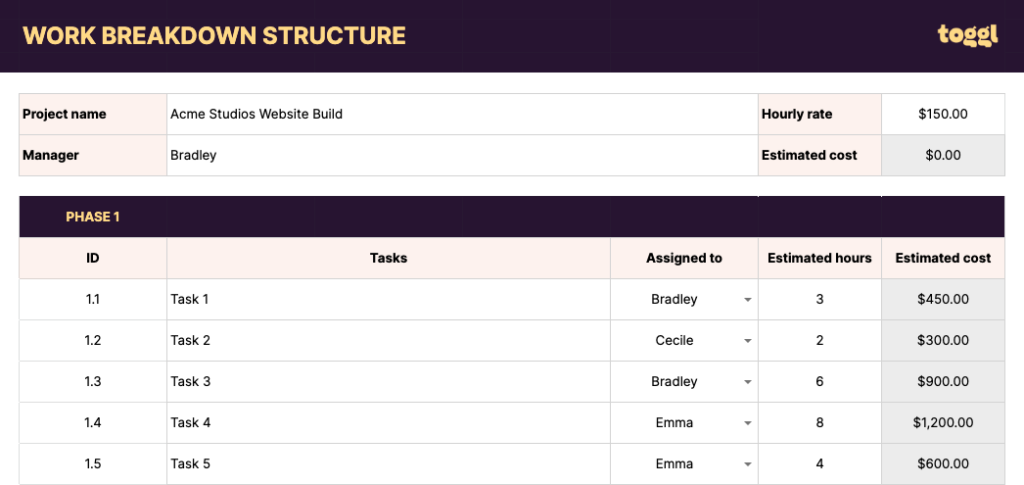
3. Break each project phase or deliverable into smaller tasks
This step involves identifying the critical factors in completing a phase/deliverable and breaking them down into manageable components.
These will be the tasks you need to be done to get each phase or deliverable over the line.
Each phase may fit into your weekly sprints if you work using agile methodologies and want to take a phased approach.
Check out this video below to learn more about using a phased sprint approach.
Being precise at this stage is critical here. Remember, items must be mutually exclusive and come together to make up 100% of your project.
Give your WBS document to your team and get them to fill each phase out. More often than not, agency projects involve different people from different departments. So rely on their knowledge and experience here.
4. Assign a time estimate to each task
This can be done during the phase above. Your team can use their knowledge and experience here. You can also use a WBS from similar past projects to speed this up.

Alternatively, using Toggl Track, you can view past project data within the project dashboard to better understand what tasks, time, and costs went into each task.

5. Double-check that your tasks are unique
Double-check your tasks are unique to ensure you’re as efficient as possible.
You need your tasks to be:
- Independent of other tasks and not duplicated elsewhere in the WBS
- Broken down as far as possible without going too far
Yes, it’s possible to go too far. Breaking down a task until it’s manageable is what you’re aiming to do — but break it down too far, and you end up micromanaging your team.
For example, it is enough to specify “keyword research” as a task. But adding ‘Select 5 competitors and add them into ‘X’ SEO tool for analysis’ is going a little too deep.
Try and apply the 8/80 rule here if you’re stuck on how far to break down each phase or deliverable.
This rule states that a task shouldn’t take less than 8 hours or more than 80 hours to complete. When in doubt, apply the “if it makes sense” rule and use your best judgment.
This rule can also help you chunk work into days if that’s how you prefer to work.
6. Share the final WBS with your team and gather feedback
Ask your team for a final review of the WBS and fill in gaps where needed. You want you and your team to take the time to build and review the WBS.
It may feel like a pain to start. But it can be the foundation to create a much more accurate estimate for a proposal and all projects moving forward.
Tips when creating a Work Breakdown Structure
A list of critical elements to consider when creating your WBS.
- A hierarchical structure
- The 100% rule
- Mutually exclusive elements
- Outcome-oriented elements
Think of this as your checklist to success. ✅
A hierarchical structure
Work Breakdown Structures should be hierarchical. A hierarchical structure displays information from the highest to the lowest level.
Every task has a relationship with the one above it. The hierarchy shows the progress of time and which tasks depend on other tasks.

Add WBS coding each time. This coding means numbering individual tasks in decimal sequence from top to bottom for easy identification.
The 100% rule
Every Work Breakdown Structure follows the 100% rule. A WBS accounts for 100% of the project and every task needed.
If it contributes one percent to the final product, it should be in the WBS.
The idea is to ensure that nothing gets left out to ensure your project estimates are as accurate as possible. This level of specificity means that you eliminate the risk of missing anything.
This breakdown in tasks will also help you to create your project timeline and schedule.
Mutually exclusive elements
Each WBS element should be mutually exclusive.
For example, if one task is “Review animation” and one is “Check animation for quality,” two people could do the same job.
You have to be more specific than this. So in this example, you would label the first task “First animation review” and the second task “Final quality check”.
This will help eliminate work overlap, reduce miscommunication, reduce confusion, and avoid duplicate work.
Outcome-oriented elements
Your Work Breakdown Structure should focus on the outcomes rather than the activities.
Do this by
- Describing elements with nouns over verbs
- Focusing on what an activity accomplishes—and write that
For example, the task is ‘Design first draft of logo’ and the outcome-oriented version is ‘First draft of the logo.’
Purpose of a Work Breakdown Structure
Some of the biggest causes of project failure are inadequate requirements gathering (35%) and inadequate vision or goal (29%). And both can be avoided by using a WBS.
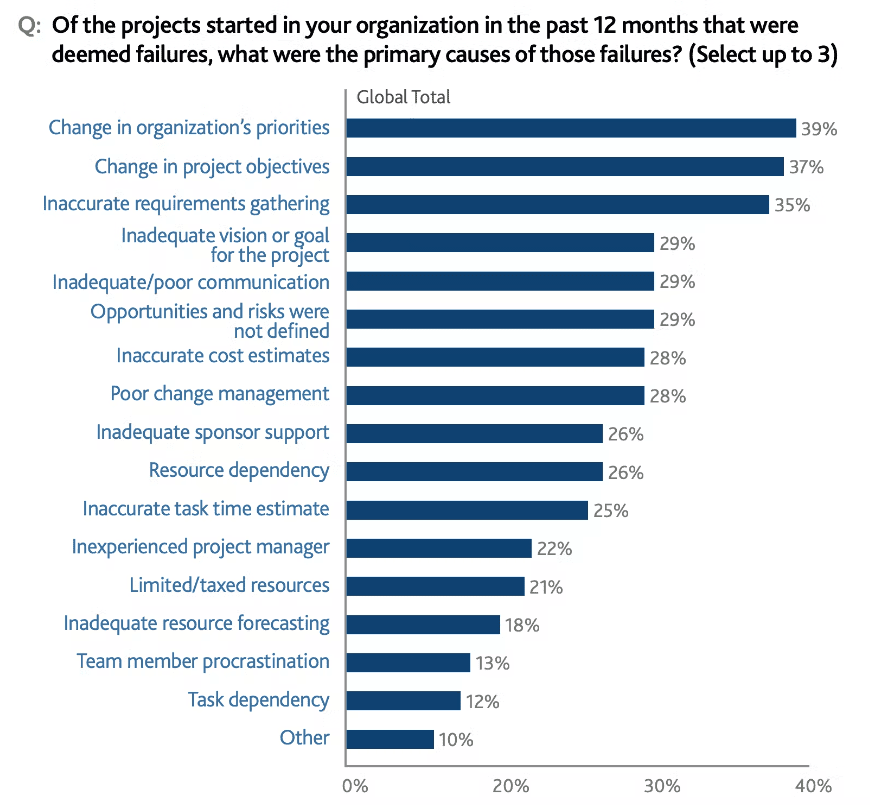
Agencies tend not to dive into the technicalities of project management, which makes sense. After all, the project management body of knowledge is stupidly vast.
The latest PMBOK® Guide has 368 pages.
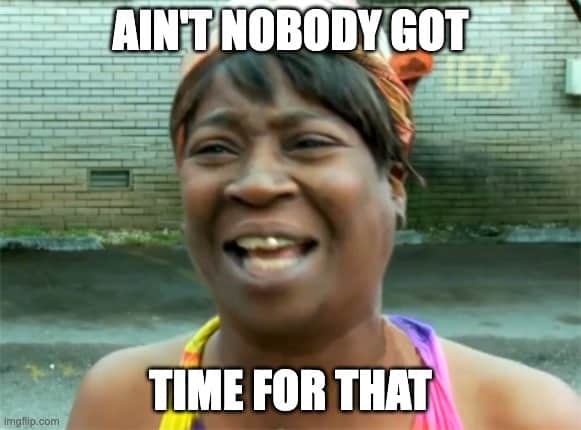
But that’s not to say there isn’t an opportunity to uncover something that will drastically improve how your approach your project work.
I’ve worked at an agency myself. So I get it. The hunt for client work is 24/7.
But most often than not, agencies will wait until AFTER a contract has been signed before fully scoping out a project. 💀
Creating a WBS during the project discovery phase will help you to get a handle on the scope, cost and deliverables needed.
Benefits of creating a Work Breakdown Structure
Let’s look at some benefits of using a WBS during the project discovery phase.
1. Increases the accuracy of project estimates
All tasks will have been accounted for, with costs associated with each.
2. Acts as a roadmap for your project plan and team
Provides team members with an understanding of where their pieces fit into the overall project management plan, indicating their work’s impact on the project.
3. It helps to prevent scope creep
It visualizes the impact when deliverables/tasks are falling behind. Helping you manage the project workload better. Preventing work from slipping through the cracks.
4. Help to build your project schedule and timeline
It facilitates the quick development of a schedule by allocating time estimates to each task. Helping you create a solid project timeline.
5. Improves resource allocation
It will help determine the resources you need for the project based on the tasks required. These include the competence requirements, the number of staff, skill set, etc.
6. It helps to establish a predictable workflow
It provides a proven and repeatable approach to scoping projects. Helping to establish a process you and your team are familiar with.
7. Identify potential bottlenecks
You may realize you need to work with external contractors once you fully understand what it will take to finish the project. Helping with any bottlenecks that may hold the project up.
Does every project need a Work Breakdown Structure?
Every project manager has some idea of what they are doing, how long they think things will take, and how much they think it will cost.
But imagine if all your projects were less stressful, more profitable, and ran like clockwork.
I’m not saying a WBS is the silver bullet here. But no matter how simple, it can contribute to helping you to run projects that little bit better.
One tool to rule them all
Knowing how to create a WBS is a fantastic tool stashed in the mind of a well-prepared project manager. It can integrate scope, cost, and deliverables into one.
Follow our step-by-step process alongside our WBS template, and you’ll be on the right path to smoother-running projects.
Here are a few helpful resources to take your project management skills to the next level.
- How To Write A Compelling Marketing Proposal In 9 Steps
- How To Create A Marketing Project Plan: A Step-by-Step Guide
- Project Estimation Techniques: A PM’s Handbook
- Project Cost Estimating: How to Nail Your Estimates
- How to Create and Manage a Winning Project Budget
Sean is a Content Marketer at Toggl. He's been involved in SEO and Content Marketing since 2017. Before working for Toggl, Sean ran SEO at a digital marketing agency—so he's all too familiar with time tracking and project management.


